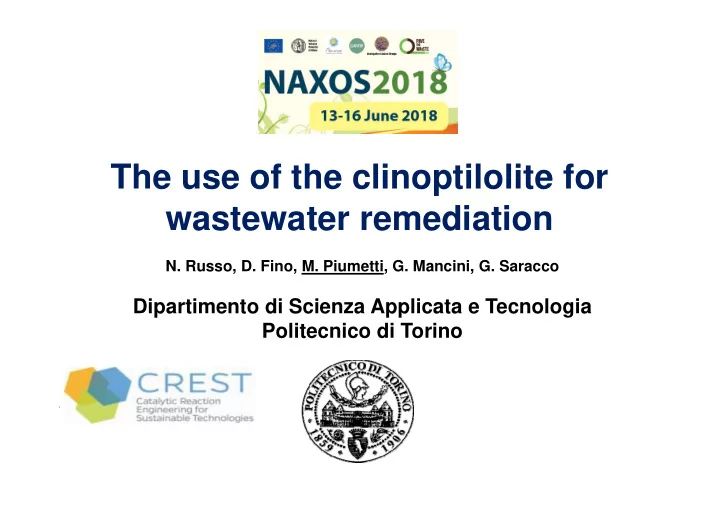

The use of the clinoptilolite for wastewater remediation N. Russo, D. Fino, M. Piumetti, G. Mancini, G. Saracco Dipartimento di Scienza Applicata e Tecnologia Politecnico di Torino
OUTLINE • CHARACTERIZATION: Physico-chemical properties of the clinoptilolite • ADSORPTION: Adsorption tests with Methylene Blue • ADSORPTION: Adsorption tests with metals (Cd and Zn) • CATALYSIS: Catalytic degradation of Acid Orange 7 using Fe-cointaining clinoptilolite
Physico-chemical properties of the clinoptilolite There are more than 50 natural and 150 synthetic types of zeolites. Natural clinoptilolite is the most widely used type due to its high absorption rate, cation exchange, catalysis and dehydration capacities. EDS values The crystal structure of clinoptilolite with cation positions. http://www.iza-online.org
Physico-chemical properties of the clinoptilolite TEM XRD Textural properties (N 2 sorption at 77 K) Adsorption-desorption isotherms FESEM M. Dosa, M. Piumetti, S. Bensaid, N. Russo, O. Baglieri, F. Miglietta, D. Fino, JACST, 2018
Adsorption tests with Methylene Blue Concentration (a), abatement (b) and quantity (c) of MB absorbed as function of the time for the solution 250 mg l -1 (5 g of clinoptilolite) MB abatement > 90 % after 20 min. and 96 % after 2 h, under stirring conditions, room temperature M. Dosa, M. Piumetti, S. Bensaid, N. Russo, O. Baglieri, F. Miglietta, D. Fino, JACST, 2018
Adsorption tests with metals (Cd and Zn) (with the contribute of Ing. Camilla Galletti) 100 100 Cd (200 ppm) Zn (200 ppm) 80 80 -1 10 g l Adsorption (%) Adsorption (%) -1 20 g l 60 60 -1 40 g l -1 60 g l -1 10 g l -1 20 g l 40 40 -1 40 g l -1 60 g l 20 20 0 0 0 20 40 60 80 100 120 140 160 180 0 20 40 60 80 100 120 140 Time (min.) Time (min.) High metal adsorption capacity was achieved for the clinoptilolite (either adsorption or ion-exhange properties)
Physico-chemical properties of the Fe-clinoptilolite Synthesis of the 3 wt.% Fe-Clin by the ion-exhange method: iron (III) nitrate was added to the solution containing clinoptilolite (Clin). The mixture was stirred for 2 hours at 50 ° C and subsequently the slurry solution was centrifugated for 10 minutes. Then, the powder was washed with deionized water, dried overnight and finally calcinated at 550 ° C for 4 h. EDS values Element Clinoptilolite Weight (%) Fe-Clinoptilolite Weight (%) 1 O 41.7 ± 0.4 52.4 ± 0.4 Si 39.9 ± 0.3 33.2 ± 0.33 Al 7.8 ± 0.2 6.2 ± 0.15 K 5.5 ± 0.2 2.2 ± 0.12 Ca 2.8 ± 0.2 2.0 ± 0.13 Fe 1.7 ± 0.2 3.6 ± 0.26 Mg 0.5 ± 0.1 0.3 ± 0.06 Na 0.1 ± 0.00 - N - - Tot. 100.00 100.00
Physico-chemical properties: The comparative sample 3 wt.% Fe-ZSM-5 EDS values for the comparative sample (3 wt.% Fe-ZSM-5) prepared by the ion-exchange method of the ZMS-5 zeolite Element Fe-ZSM-5 Weight (%) O 55.2 ± 0.4 Si 40.7 ± 0.3 Al 1.5 ± 0.1 K - Ca - Fe 3.1 ± 0.2 Mg - Na - N 0.5 ± 0.1 Tot. 100.00 ZSM-5
Physico-chemical properties: XRD diffractograms Clinoptilolite, Fe-Clinoptilolite ZSM-5 and Fe-ZSM-5 The introduction of 3 wt.% Fe does not modify the XRD patterns No FeO x clusters (XRD, XPS data)
Azo-dye molecule: Acid Orange 7 Schematization of azo- and hydrazone structures of AO7 along with the UV-Vis spectrum in water
Catalytic degradation of AO7 Fe-Clin Fe-ZSM-5 The Fe-Clin sample exhibited the best performances towards the AO7 degradation (in terms of AO7 total conversion, %), particularly in the presence of both ascorbic acid and H 2 O 2 (Fenton-type mechanism).
Conclusions • Clinoptilolite is a natural zeolite effective for the adsoption of organic molecules and metals. • A new Fe-containing clinoptilolite (3 wt.% Fe-Clin) sample was prepared by the ion-exhange method. • The Fe-Clin exhibited good performances for the degradation of AO7 in the presence of both ascorbic acid ad H 2 O 2 . • The Fenton-type activity of the Fe-Clin is higher than that achived for the Fe-ZSM-5.
Thanks for your kind attention! Acknowledgments Zeolado (https://zeolado.gr) and prof. Lygeros in providing the clinoptilolite used for investigations are gratefully acknowledged. The “RheoCom” project funded by Politecnico di Torino and Compagnia di SanPaolo, Turin, Italy.
Recommend
More recommend